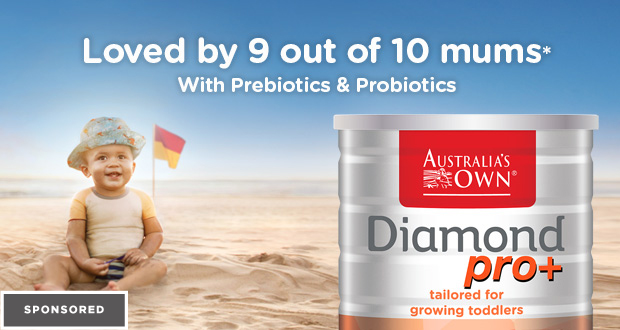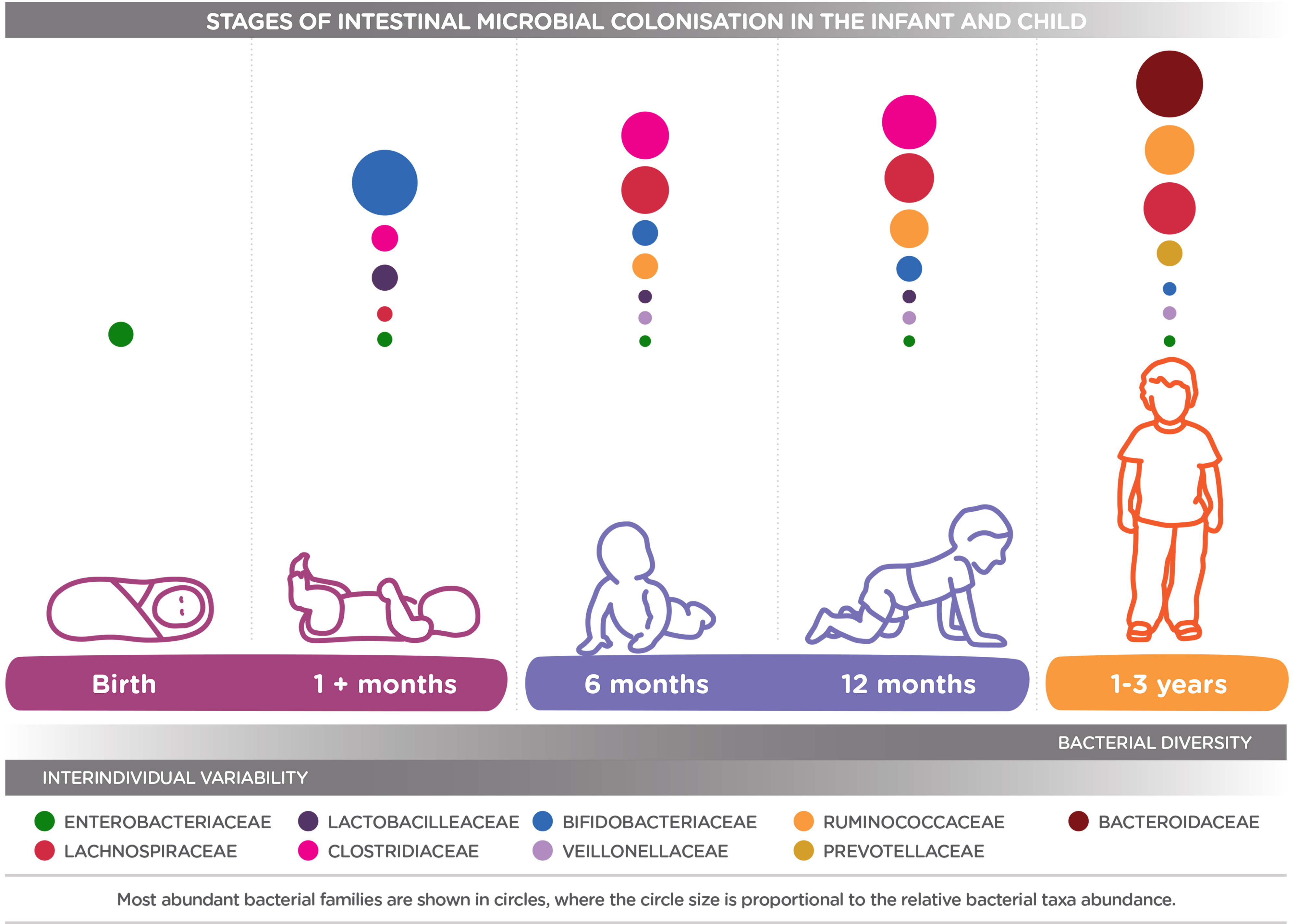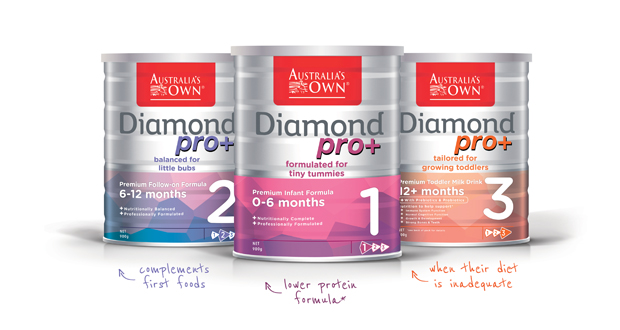What is the Gut Microbiota?
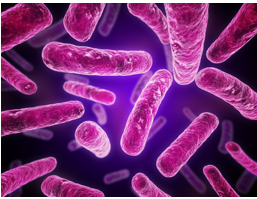
Figure 1: The Gut Microbiota is colonised during the first 1000 days of life and affects both health and disease outcomes
The human body is inhabited by trillions of microbes, mostly bacteria but also viruses and fungi (1). The majority of these microbes inhabit the human intestinal system, which is called the gut microbiota (Figure 1).
In healthy adults, most of the intestinal bacteria reside in the large bowel, where the population is highly diverse (with hundreds of bacterial species) and numerous, with the number of bacterial cells exceeding those of the host (1, 2). The human gut microbiota is also highly dynamic and changes throughout life.
Other densley populated microbial areas include the skin, the oral cavity and the upper respiratory tract (3).
A healthy gut microbiota is characterised by a diverse mix of gut bacteria and a suitable balance between ‘beneficial’ and ‘harmful’ gut microbes, and can be influenced by many factors including environmental influences like antibiotic use, place of birth and dietary habits (1, 4, 5).
For example, researchers have identified differences in the gut microbiota composition between children living in Africa eating a traditional, plant-based fibre rich diet and children living in Europe consuming a processed, modern Western diet (5). The African children were found to have more types of bacteria (so, greater bacteria diversity), more anti-inflammatory bacteria and also some of the ‘beneficial’ bacteria types found in the African children’s gut microbiota were altogether absent in the European children.
While we don’t know exactly how to make sure a healthy microbiota is achieved, we do know it’s really important to have a good diet rich in diverse fibre types.
Did you know? Dietary habits are considered one of the main factors that contribute to the diversity of the human gut microbiota (6).
Why is a healthy Gut Microbiota important?
More than 20 years ago, this was summed up nicely by American researcher Dr Berg as “The indigenous gastrointestinal microflora has profound effects on the anatomical, physiological and immunological development of the host. The indigenous microflora stimulates the host immune system to respond more quickly to pathogen challenge…” (3).
So, a healthy Gut Microbiota helps keep a healthy human. The bacteria here play a role in breaking down or digesting certain types of fibre and other dietary compounds and absorbing other nutrients from the diet (e.g. calcium). Other complex microbiota functions include the production of biologically important end-products, like the short chain fatty acids called lactic acid and butyric acid (a mediator of colonic health) and enzymes important in the metabolism of several vitamins (4, 7, 8). The gut microbiota is also thought to influence brain function and mood (9).
On the other hand, disruptions in the gut microbiota can impact various disease states, including allergy, ulcerative colitis, Crohn's disease, diabetes, obesity and malnutrition (10). In grown humans, the dominant bacterial phyla are Firmicutes and Bacteroidetes (11), with disturbances in the ratio between these phyla (and in the diversity and abundance of the bacteria within these phyla) thought to affect health outcomes (5).
What are Prebiotics & Probiotics and Are they Important??
Most of us are familiar with Probiotics and know they can be found in food like yoghurt (the fresher the better) and fermented food like sauerkraut and kimchi. We also understand that it may be useful to increase our intake of probiotics following a course of antibiotic treatment, to prevent some of the penicillin-mediated changes in the microbiota (12).
Probiotics are defined as living microorganisms that, when administered in adequate amounts, provide some health benefit to the person receiving them (13). Essentially, they are living, beneficial and healthy bacteria that help to create a healthy gut bacteria profile.
Prebiotics are the less well known associate but are perhaps the more important of the two.
Prebiotics are defined as substrates that are “selectively utilized by host microorganisms conferring a health benefit” (14). That is, through feeding the beneficial gut microbes, prebiotics result in positive changes in the composition and/or activity of the gut microbiota, providing knock on health benefits to the host.
The most common prebiotics are the indigestible galactooligosaccharides (GOS) and fructooligosacchardies (FOS) that escape digestion in the small intestine and selectively feed the indigenous microbiota (probiotics) in the large intestine, with their effects largely acting through enrichment of Bifidobacterium and/or Lactobacillus (14, 15). These oligosaccharides (which are a soluble fibres), have documented effects on immune function and metabolism (16).
Watch this short animation for a quick example of how Prebiotics & Probiotics work together in their synbiotic way.
Gut Microbiota Development in Babies – A Golden Window of Opportunity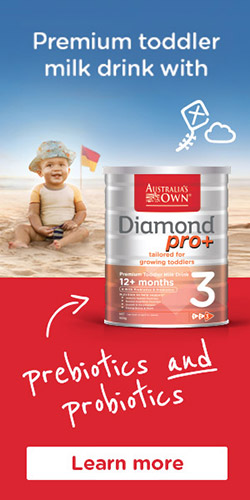
An infant’s gut bacteria profile is seeded during the first 1000 days of life and a healthy gut microbiota has important health implications across the lifespan, with beneficial nutrition, immunological and developmental effects observed (10, 16).
Important factors that shape an infant’s gut microbiota include the mode of delivery and the method of feeding (i.e. breastfeeding compared with formula feeding and then solid foods), as well as premature versus term gestational age (3, 19). Thus, weaning foods and other foods introduced during the first and second year of life are important contributors. A variety of plant based, diverse fibre type foods is a great place to start, while making sure iron and iodine rich foods also make a good contribution.
The maternal microbiota is also emerging as potential risk or protective factor for allergic and other disease states in the offspring (16). So, dietary and other influences on the maternal microbiota are important considerations in terms of infant wellbeing and effects on an infant’s developing gut microbiota (17).
Did you know? We used to think that the infant gut was sterile at birth (i.e. germ free) and that his or her gut was first inoculated on exposure to mum’s microbiota during birth (18). However, emerging evidence now suggests a prenatal effect on an infant’s microbial expression(2, 17, 18). Figure two shows the stages of intestinal microbial colonisation in the infant.
Figure adapted from reference 17
Figure 2: Stages of intestinal microbial colonisation in the infant and child. The intestinal microbiota of the newborn is initially colonised by Enterobacteria. During the first month, Bifidobacteria and Lactobacillus species (generally known as lactic acid producing bacteria) dominate, with an expansion of Clostridial members (Lachnospiracea, Clostridiaceae and Ruminococcaceae) as solid food is introduced at around 6 months. In the following months, members of the Ruminococcaceae family continue to proliferate. While there are differences between formula and breast fed infants in these early months, the transition to solid food has a significant role in shaping the gut bacteria composition and around this time, the infant’s gut microbiota becomes seeded with species prevalent in adults. By 2-3 years of age, the microbiota composition consists mainly of Bacteroidaceae, Lachnospiraceae and Ruminococcaceae, which then remains stable into adulthood (1, 2, 17, 19-22).
Prebiotics & Probiotics in Infant Feeding
Quick Prebiotic Fact Human breast milk contains many complex prebiotics, called human milk oligosaccharides (HMO). These make up around one third of the composition of breast milk (23). These HMOs have been shown to bring important health benefits to the developing baby, including to the infant’s immune system and gut bacteria (23).
The Bifidobacterium and Lactobacillus bacteria that dominate the infant’s gut microbiota during the first year grow robustly on human milk oligosaccharides (23).
Oligosaccharides and more specifically GOS have also been shown to increase levels of the beneficial Bifidobacterium and Lactobacillus bacteria (14, 15, 24), demonstrating that these early life dominant gut bacteria also grow with GOS. Prebiotics also help to maintain softer stools in babies, helping to keep babies regular (25).
Research on the composition of human breast milk and the importance of human milk oligosaccharides to the infant gut microbiota highlight the value of prebiotic oligosaccharides during early life nutrition (25).
Quick Probiotic Fact Like breast milk and prebiotics, breast milk also contains its own probiotics (26). It appears that lactating mothers pass these probiotics on to her feeding infant.
In babies, supplementation with the probiotic called Bifidobacterium lactis Bb12 has been shown to significantly reduce the number of episodes of gastrointestinal infections relative to not having the probiotics (27).
In conclusion, the development of the Gut Microbiota during the first 1000 days of a child’s life can have enduring effects on health and wellbeing. Therefore, focusing efforts on ensuing infants reach their Gut Microbiota genetic potential through dietary and other environmental exposures deserves focus and priority attention.
Diamond pro+ 1 Premium Infant Formula 0-6 months is nutritionally complete and lower in protein than leading competitors and is based on the latest nutrition science. Contains essential nutrients, vitamins and minerals.
Diamond pro+ 2 Premium Follow-On Formula 6-12 months contains more iron than Stage 1, consistent with the NHMRC recommendation to increase dietary iron intakes between 7-12 months of age. It also contains everything they need to support this rapid phase of growth, while introducing solid foods.
Diamond pro+ 3 Premium Toddler Milk Drink 12+ months with Prebiotics & Probiotics is formulated to help keep up with the nutritional needs of active toddlers when their diet is inadequate, providing 15–50% of their daily allowance of 16 essential vitamins and minerals per serve. Diamond pro+ 3 also contains comparable energy and protein levels to regular cow’s milk.
Interested in finding out more about the Diamond pro+ Difference?
Contact our Healthcare Professionals on
PH: 1800 646 231
[email protected]
or visit aodiamondnutrition.com.au
|
||
|
Freedom Foods Group Limited is a signatory to the Marketing in Australia of Infant Formulas: Manufacturers and Importers Agreement (MAIF Agreement)
|
References
1. Palmer C, et al. Development of the human infant intestinal microbiota. PLoS Biology. 2007;5(7):e177. 2. Nuriel-Ohayon M, et al. Microbial Changes during Pregnancy, Birth, and Infancy. Frontiers Microbiology. 2016;7:1031. 3. Berg RD. The indigenous gastrointestinal microflora. Trends Microbiology. 1996;4(11):430-5. 4. Gorbach SL. Microbiology of the Gastrointestinal Tract. In: Baron S, editor. Medical Microbiology. Galveston (TX)1996. 5. De Filippo C, et al. Impact of diet in shaping gut microbiota revealed by a comparative study in children from Europe and rural Africa. Proceedings National Academy of Sciences USA. 2010;107(33):14691-6. 6. Backhed F, et al. Host-bacterial mutualism in the human intestine. Science. 2005;307(5717):1915-20. 7. Bird AR, et al. Resistant starch, large bowel fermentation and a broader perspective of prebiotics and probiotics. Beneficial Microbes. 2010;1(4):423-31. 8. Topping D, Conlon MA. Feeding a hungry microbiome: large bowel fermentation and human health. Medical J. Australia. 2014;201(8):438. 9. Dash S, et al. The gut microbiome and diet in psychiatry: focus on depression. Current Opinion Psychiatry. 2015;28(1):1-6. 10. Clemente JC, et al. The impact of the gut microbiota on human health: an integrative view. Cell. 2012;148(6):1258-70. 11. Rajilic-Stojanovic M, et al. Development and application of the human intestinal tract chip, a phylogenetic microarray: analysis of universally conserved phylotypes in the abundant microbiota of young and elderly adults. Environmental Microbiology. 2009;11(7):1736-51. 12. Korpela K, et al. Lactobacillus rhamnosus GG Intake Modifies Preschool Children's Intestinal Microbiota, Alleviates Penicillin-Associated Changes, and Reduces Antibiotic Use. PloS One. 2016;11(4):e0154012. 13. Guarner F, et al. World Gastroenterology Organisation Global Guidelines: Probiotics and Prebiotics. 2017. 14. Gibson GR, H et al. Expert Consensus Document: The International Scientific Association for Probiotics and Prebiotics (ISAPP) Consensus Statement on the Definition and Scope of Prebiotics. Nature Reviews Gastroent. & Hepatology. 2017;14(8):491-502. 15. Rastall RA. Bacteria in the gut: friends and foes and how to alter the balance. J. Nutrition. 2004;134(8 Suppl):2022S-6S. 16. Prescott SL. Early Nutrition as a Major Determinant of 'Immune Health': Implications for Allergy, Obesity and Other Noncommunicable Diseases. Nestle Nutrition Institute workshop series. 2016;85:1-17. 17. Arrieta MC, et al. The intestinal microbiome in early life: health and disease. Frontiers Immunology. 2014;5:427. 18. Willyard C. Could baby's first bacteria take root before birth? Nature. 2018;553(7688):264-6. 19. Obermajer T, et al. Microbes in Infant Gut Development: Placing Abundance Within Environmental, Clinical and Growth Parameters. Sci. Reports. 2017;7(1):11230. 20. Lawley B, et al. Differentiation of Bifidobacterium longum subspecies longum and infantis by quantitative PCR using functional gene targets. PeerJ. 2017;5:e3375. 21. Stark PL, Lee A. The microbial ecology of the large bowel of breast-fed and formula-fed infants during the first year of life. J. Medical Microbiology. 1982;15(2):189-203. 22. Backhed F, et al. Dynamics and Stabilization of the Human Gut Microbiome during the First Year of Life. Cell Host & Microbe. 2015;17(5):690-703. 23. LoCascio RG, et al. Broad conservation of milk utilization genes in Bifidobacterium longum subsp. infantis as revealed by comparative genomic hybridization. Applied Environ. Microbiology. 2010;76(22):7373-81. 24. Davis LM, et al. Barcoded pyrosequencing reveals that consumption of galactooligosaccharides results in a highly specific bifidogenic response in humans. PloS One. 2011;6(9):e25200. 25. Skorka A, et al. Infant formulae supplemented with prebiotics: Are they better than unsupplemented formulae? An updated systematic review. British J. Nutrition. 2018;119(7):810-25. 26. Fernandez L, et al. The human milk microbiota: origin and potential roles in health and disease. Pharmacological Research. 2013;69(1):1-10. 27. Skorka A, et al. To add or not to add probiotics to infant formulae? An updated systematic review. Beneficial Microbes. 2017;8(5):717-25.
Do you have an idea for a story?
Email [email protected]
 Nursing Review The latest in heathcare news for nurses
Nursing Review The latest in heathcare news for nurses
